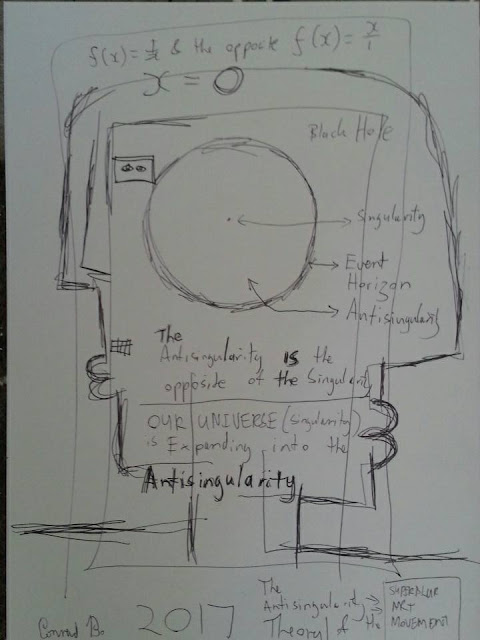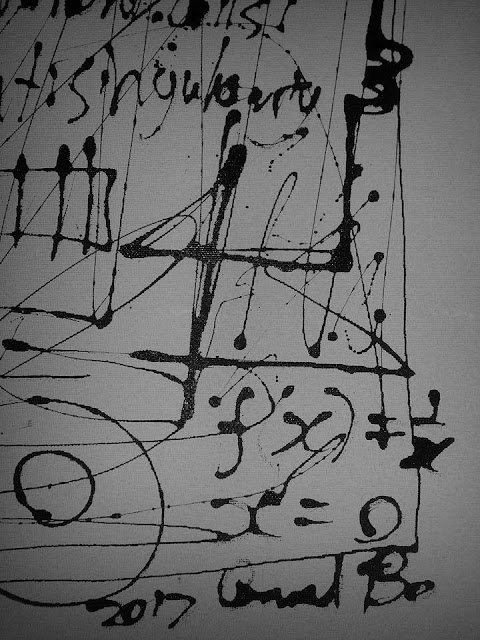The Anti Singularity Theory (Antisingularity) and Black Holes
I try to explain the Anti Singularity Theory, it is important to look at our current understanding of Black Holes.
In the Anti Singularity theory I propose that the space between a Singularity of a Black Hole and the Event Horizon is called the Anti Singularity (Antisingularity). In the Anti Singularity (Antisingularity) the density is zero and the volume is infinite (compared the the Singularity). The Universe consists of 3 things, Singularities, expanding Singularities and the Anti Singularity (Antisingularity).
Black holes are one of the most intriguing and fascinating objects in the universe. They are characterized by their immense gravitational pull, which is so strong that even light cannot escape from it. In this paper, we will describe a black hole in terms of mathematics and equations. Mathematical Description: A black hole is described by the Schwarzschild metric, which is a solution to the Einstein field equations of general relativity. The metric is given by: ds^2 = -(1 - 2GM/rc^2)dt^2 + (1 - 2GM/rc^2)^-1 dr^2 + r^2(dθ^2 + sin^2 θ dϕ^2) where ds^2 is the spacetime interval, G is the gravitational constant, M is the mass of the black hole, c is the speed of light, r is the distance from the center of the black hole, and θ and ϕ are the angular coordinates. The Schwarzschild metric describes the curvature of spacetime around a non-rotating, spherically symmetric black hole. The first term in the metric, -(1 - 2GM/rc^2)dt^2, describes time dilation near the black hole, where time appears to slow down as one gets closer to the event horizon. The second term, (1 - 2GM/rc^2)^-1 dr^2, describes the distortion of space near the black hole, where distances appear to be shorter as one gets closer to the event horizon. The event horizon is the boundary around the black hole beyond which nothing, not even light, can escape. The event horizon is located at the radius where the Schwarzschild metric becomes infinite, r = 2GM/c^2. Conclusion: In conclusion, a black hole is a gravitational singularity characterized by its immense gravitational pull. It is described mathematically by the Schwarzschild metric, which is a solution to the Einstein field equations of general relativity. The metric describes the curvature of spacetime around a non-rotating, spherically symmetric black hole and predicts the existence of an event horizon beyond which nothing can escape. The Schwarzschild radius is a fundamental concept in black hole physics that describes the size of the event horizon of a black hole. The event horizon is the boundary around a black hole beyond which nothing, not even light, can escape. Anything that crosses the event horizon is irreversibly pulled into the black hole's singularity. The formula for the Schwarzschild radius is given by: r_s = 2GM/c^2 where G is the gravitational constant, M is the mass of the black hole, and c is the speed of light. In practical terms, the Schwarzschild radius determines the size of the event horizon of a black hole, which depends on the mass of the black hole. The greater the mass of the black hole, the larger its Schwarzschild radius, and therefore, the larger its event horizon. For example, a black hole with the mass of the sun would have a Schwarzschild radius of approximately 3 kilometers, while a supermassive black hole with a mass of one billion suns would have a Schwarzschild radius of approximately 3 million kilometers. It's important to note that the Schwarzschild radius is a theoretical concept and cannot be observed directly. However, it is a crucial concept in understanding the behavior of black holes and their effects on their surroundings, such as the way they distort spacetime and the way they accrete matter from their surroundings. Yes, a black hole with one solar mass is possible. In fact, it is expected that many such black holes exist in our galaxy and in other galaxies throughout the universe. When a massive star runs out of fuel and its core collapses, the core can become so dense that it forms a black hole. The minimum mass required for a star to form a black hole is about 3 solar masses. However, if the star loses mass through stellar winds or other mechanisms before it collapses, the resulting black hole can have a lower mass, including one solar mass. In addition to stellar black holes, there are also so-called primordial black holes that could have formed during the early universe. These black holes would have formed from fluctuations in the density of matter shortly after the Big Bang. Primordial black holes with masses ranging from 10^-18 to 10^5 solar masses are theoretically possible, including black holes with one solar mass. Although black holes with one solar mass are possible, they are not directly observable because they do not emit any radiation or light. However, their existence can be inferred from their gravitational effects on nearby matter, such as stars orbiting around them or gas falling into them. The nature of singularities within black holes is still not well understood. However, based on our current understanding of physics and the properties of black holes, it is not thought to be possible for a singularity within a black hole in our observable universe to start expanding. A singularity is a point of infinite density and zero volume, and our current understanding of physics breaks down at such extreme conditions. Therefore, we cannot say for certain what would happen to a singularity within a black hole if it were to start expanding. However, it is thought that the intense gravitational forces within a black hole would prevent any kind of expansion from occurring. As matter falls into a black hole, it becomes increasingly compressed and heated, eventually reaching the point where it is crushed down to a singularity. At this point, the gravitational pull of the singularity is so strong that even light cannot escape, and any attempt at expansion would be met with an even stronger gravitational force pulling everything back in. Furthermore, the laws of thermodynamics suggest that an expanding singularity would violate the second law of thermodynamics, which states that entropy (or disorder) always increases over time. An expanding singularity would result in a decrease in entropy, which is not allowed under the second law. Therefore, while we cannot rule out the possibility of an expanding singularity within a black hole in our observable universe, it is not currently thought to be a likely scenario based on our current understanding of physics and the properties of black holes. The Big Bang, as we currently understand it, was an unlikely scenario from a certain perspective. The Big Bang theory suggests that the entire universe was once compressed into an infinitely small point, or singularity, and then expanded rapidly in a fraction of a second, eventually giving rise to the universe we observe today. However, while the Big Bang was an unlikely scenario, it is supported by a vast amount of observational evidence from cosmology, such as the cosmic microwave background radiation and the observed large-scale structure of the universe. The Big Bang theory has been extensively tested and refined over many decades, and it is currently the most widely accepted explanation for the origin and evolution of the universe. On the other hand, the scenario of an expanding singularity within a black hole is not currently supported by observational evidence or theoretical models. While it is not necessarily impossible, it is not a likely scenario based on our current understanding of the properties of black holes and the laws of physics. In any case, it is important to remember that our understanding of the universe is constantly evolving and subject to revision as new evidence and theories emerge. The nature of the universe at its earliest moments and at the singularity of the Big Bang is still not well understood. However, current cosmological models suggest that the universe as a whole is not a singularity and is not expanding from a single point. The current leading theory for the evolution of the universe is the Big Bang theory, which suggests that the universe began in a hot, dense state and has been expanding and cooling ever since. However, the Big Bang theory does not describe the universe as a singularity or an expanding singularity, but rather as an expanding and evolving space-time. The universe is thought to have started out extremely small and dense, but not as a point-like singularity. Furthermore, recent observations of the cosmic microwave background radiation, the afterglow of the Big Bang, suggest that the universe is almost perfectly homogeneous and isotropic on very large scales, which is not consistent with a universe that originated from a single point-like singularity. So, while we cannot rule out the possibility that the universe is a singularity, it is not currently supported by observational evidence or theoretical models. The current understanding of the universe suggests that it is expanding and evolving in a complex way, but not from a single point-like singularity. According to the Big Bang theory, the universe started as an extremely hot, dense point or singularity that rapidly expanded and cooled. However, it is important to note that this singularity is not thought to be a point in physical space, but rather a mathematical concept that describes the state of the universe at that very early time. At the very earliest moments of the universe, the laws of physics as we currently understand them break down, and we cannot describe the universe in terms of space and time as we normally think of them. Instead, we use mathematical models to describe the behavior of the universe at these extreme conditions. The singularity at the beginning of the universe is not a point in physical space that is expanding outward into some pre-existing space, but rather a singularity in the curvature of space-time itself. As the universe expands, the curvature of space-time changes, and the distances between objects increase. So while we are part of the universe that started expanding from the singularity, the singularity itself is not a point within the universe that is expanding outward. Rather, it is a mathematical concept that describes the state of the universe at a very early time. The current scientific consensus is that the observable universe began as a hot, dense state that rapidly expanded and cooled, which we refer to as the Big Bang. While the precise nature of this initial state is still not well understood, it is widely believed to have been a singularity, a state of infinite density and zero size. However, it is important to note that while the singularity is thought to have been the starting point of the universe, it is not necessarily the starting point of everything we observe in the universe. The universe has evolved and undergone many processes since the initial singularity, including the formation of stars, galaxies, and other structures that we observe today. So while the singularity may be the starting point of the universe as a whole, it is not necessarily the starting point of all the objects and structures that we observe in the universe. The evolution of the universe from the singularity to the present day is a complex and ongoing process that has given rise to the diverse range of objects and phenomena that we observe in the universe today. According to the current scientific understanding of the universe, everything that we observe today, including ourselves, originated from the hot, dense state of the early universe that rapidly expanded and cooled after the Big Bang. At that time, the universe was in a highly compressed state and had a high energy density, which made it behave in a way that is different from the universe we observe today. While the exact nature of the universe at the earliest moments is not yet well understood, it is believed that the universe was in a state of extreme density and temperature, and it is possible that it started as a singularity. However, it is important to note that the singularity is a mathematical concept, and it is not necessarily a point in space or a physical object. As the universe expanded and cooled, matter began to form, and eventually, stars, galaxies, and other structures formed. These structures are made up of the matter that was present in the early universe, and they continue to evolve and change over time. So, while we may have originated from the same initial state as the rest of the universe, including the singularity, it is important to remember that the universe has undergone a complex and ongoing process of evolution and change since that time. The universe we observe today is vastly different from the universe at its earliest moments, and the objects and structures within it have their own unique histories and characteristics. The matter that makes up everything we observe in the universe, including ourselves, was present in some form in the early universe. However, in the extremely hot and dense conditions of the early universe, the matter existed in a different state than the atoms and molecules that we are familiar with today. In the earliest moments of the universe, matter existed in the form of a hot plasma, which is a state of matter where the electrons are not bound to the atomic nuclei. As the universe expanded and cooled, the plasma gradually cooled and the electrons began to bind to the nuclei to form neutral atoms. This process, known as recombination, occurred when the universe was about 380,000 years old and it allowed photons to travel freely through space, giving rise to the cosmic microwave background radiation that we can observe today. After recombination, matter in the universe consisted mostly of hydrogen and helium, with small amounts of other elements. Over time, these elements began to clump together under the influence of gravity, forming the first stars and galaxies. Within these stars, nuclear fusion reactions occurred, converting hydrogen and helium into heavier elements like carbon, nitrogen, and oxygen. When these stars eventually died, they exploded in supernova explosions, releasing these heavier elements into the interstellar medium. Subsequent generations of stars and galaxies formed from this enriched material, and eventually, the elements necessary for life, such as carbon, nitrogen, and oxygen, were produced. So while the matter that makes up everything we observe today was present in some form in the early universe, it went through a series of transformations and processes over billions of years to form the atoms and molecules that make up our bodies and the world around us today. The atoms that make up everything in the universe, including the atoms in our bodies, ultimately came from the hot plasma that existed in the earliest moments of the universe. However, in the hot plasma state, the electrons and atomic nuclei were not bound together to form neutral atoms. Instead, they existed as separate charged particles that were constantly interacting with each other. It was only after the universe cooled down and expanded enough that the electrons and atomic nuclei could come together to form neutral atoms. This process, known as recombination, occurred when the universe was about 380,000 years old, and it allowed photons to travel freely through space, giving rise to the cosmic microwave background radiation that we can observe today. After recombination, the universe was mostly composed of hydrogen and helium atoms. Over time, through the process of gravitational collapse, these atoms came together to form the first stars and galaxies. Within these stars, nuclear fusion reactions occurred, converting hydrogen and helium into heavier elements like carbon, nitrogen, and oxygen. When these stars eventually died, they exploded in supernova explosions, releasing these heavier elements into the interstellar medium. Subsequent generations of stars and galaxies formed from this enriched material, and eventually, the elements necessary for life, such as carbon, nitrogen, and oxygen, were produced. So while the atoms that make up everything in the universe ultimately came from the hot plasma that existed in the earliest moments of the universe, they went through a series of transformations and processes over billions of years to form the atoms that make up our bodies and the world around us today. While the early universe was very hot and dense, it was not a singularity in the sense of a point of infinite density and curvature. Instead, the universe was simply very hot and dense, and it underwent a rapid expansion known as cosmic inflation during its earliest moments. The concept of a singularity arises in certain models of the universe, such as the mathematical model of general relativity, where it is used to describe a point of infinite density and curvature at the center of a black hole or at the beginning of the universe. However, the behavior of matter and energy in the very early universe is still not fully understood, and it is an active area of research in cosmology. So while the early universe was very different from the universe we observe today, it is not accurate to say that we are inside of a singularity or that the universe itself is a singularity. The universe is a complex and dynamic system that has undergone many transformations and changes over billions of years, and scientists are still working to understand its origins and evolution.Regards
Conrad Bo Superblur
Inventor of the Anti Singularity (Antisingularity) Theory
 |
Conrad Bo Superblur Inventor of the Anti Singularity (Antisingularity) Theory |
 |
Conrad Bo Superblur Inventor of the Anti Singularity (Antisingularity) Theory |
 |
Conrad Bo Superblur Inventor of the Anti Singularity (Antisingularity) Theory |
 |
Conrad Bo Superblur Inventor of the Anti Singularity (Antisingularity) Theory |
 |
Conrad Bo Superblur Inventor of the Anti Singularity (Antisingularity) Theory |
 |
Conrad Bo Superblur Inventor of the Anti Singularity (Antisingularity) Theory |
 |
Conrad Bo Superblur Inventor of the Anti Singularity (Antisingularity) Theory |


Comments
Post a Comment